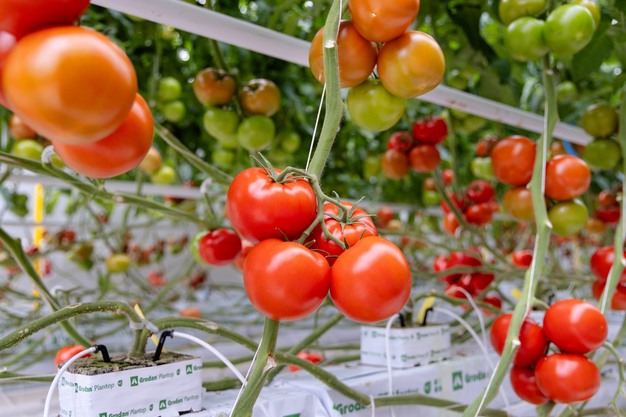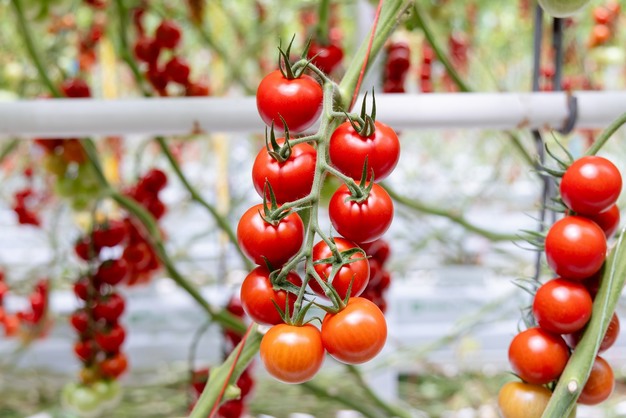 In a study executed by the B2B project of the Belgian trial stations, Bayer's two new De Ruiter varieties with Intermediate Resistance to ToBRFV played the leading role: the beef tomato Ferreira (experimental designation DRTH2911) and the cocktail tomato DRTC9518. Both tomato varieties, along with a susceptible variety, were infected with high ToBRFV concentrations in two growth chamber tests. No virus accumulation was measured in these tests. Good news, according to Jari Boerboom, Market Development Representative Tomato for Bayer's De Ruiter™ brand. The research was recently published in Belgium magazine Proeftuinnieuws.
In a study executed by the B2B project of the Belgian trial stations, Bayer's two new De Ruiter varieties with Intermediate Resistance to ToBRFV played the leading role: the beef tomato Ferreira (experimental designation DRTH2911) and the cocktail tomato DRTC9518. Both tomato varieties, along with a susceptible variety, were infected with high ToBRFV concentrations in two growth chamber tests. No virus accumulation was measured in these tests. Good news, according to Jari Boerboom, Market Development Representative Tomato for Bayer's De Ruiter™ brand. The research was recently published in Belgium magazine Proeftuinnieuws.

Research on virus
Five young plants per variety were infected with high virus concentrations in these growth chamber experiments. Eleven-day-old plants were used. In the first growth chamber test, no virus accumulation nor symptoms were detected in the resistant varieties at the end of the trial twenty-eight days post-inoculation.
However, virus accumulation and severe viral symptoms were observed in the susceptible variety that was included in the test. "This research indicates that the Intermediate Resistance to ToBRFV in our newest varieties looks promising for offering higher production reliability for growers," said Jari. "ToBRFV replication is significantly delayed thanks to our Intermediate Resistance. The results of these tests carried out as part of this trial, showed no measurable virus replication has occurred after applying a single inoculation."

Second growth chamber test
In a second growth chamber test, a low virus concentration was measured in four out of five plants fourteen days after inoculation. As the test progressed, both De Ruiter brand varieties showed a decrease in viral concentration. Endpoint detection in 50-day-old plants after sowing, showed absence of virus at 35 days post inoculation in both De Ruiter varieties. Also, in this second test, neither of the two De Ruiter varieties showed virus symptoms at any time. The plants were vigorous and voluminous. No differences between these plants and non-inoculated plants were found.
Jari adds: "The Intermediate ToBRFV Resistance we have currently achieved provides a solid basis for our portfolio. However, it's important to remember that continuous exposure to high ToBRFV concentrations (e.g., in highly infected greenhouses and in poor hygiene measures) may result in viral replication over time and overcome resistance. As a result, the implementation of strict phytosanitary measures will remain a significant part of tomato cultivation in the coming years. In addition, we will continue to pay close attention to maintaining good agronomic specifications and high yield potential in these varieties."
Continue on the same path
The current results from these Bayer De Ruiter varieties are reason to continue the path we have taken. Jari comments: "We are implementing ToBRFV resistance in an increasing number of segments. In the coming season, resistance of various levels will also be tested in several experiments under grower conditions. Our Testing and Market Development teams work together to make data-driven decisions on the advancement and marketing of new ToBRFV-resistant varieties." Bayer's De Ruiter brand also employs the new quarantine greenhouse in Wageningen for this purpose. "This quarantine greenhouse supports ToBRFV resistance testing among our youngest varieties, and it is great to see that the outcomes of this project are in line with our own results and expectations."
A durable solution
The stacking of multiple ToBRFV resistance genes is a continuous process, and Bayer De Ruiter brand's Trait Discovery and Breeding teams are, therefore, constantly looking for genes with different resistance mechanisms. "We then stack these in our parent lines. This is how we plan to create a more durable solution against ToBRFV. The virus is evolving, and so are we!"
To find out more about disease resistance and the applicable levels of disease resistance, visit www.worldseed.org and view the "Definition of the Terms Describing the Reaction of Plants to Pests for the Vegetable Industry" paper in the Vegetable Resources section.
 For more information:
For more information:
De Ruiter Seeds
www.deruiterseeds.com
